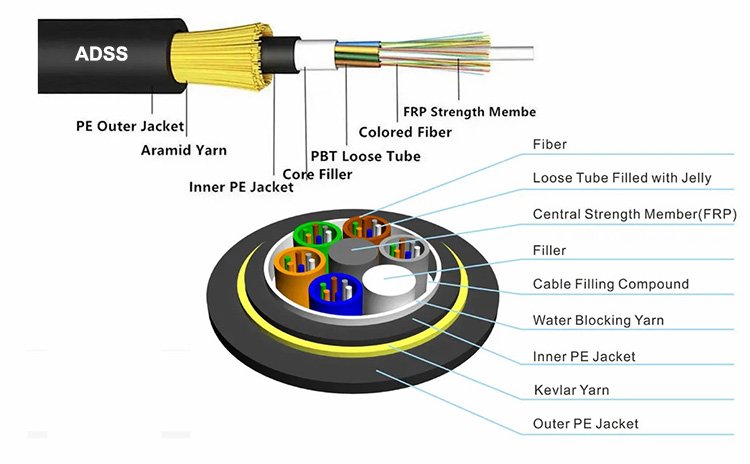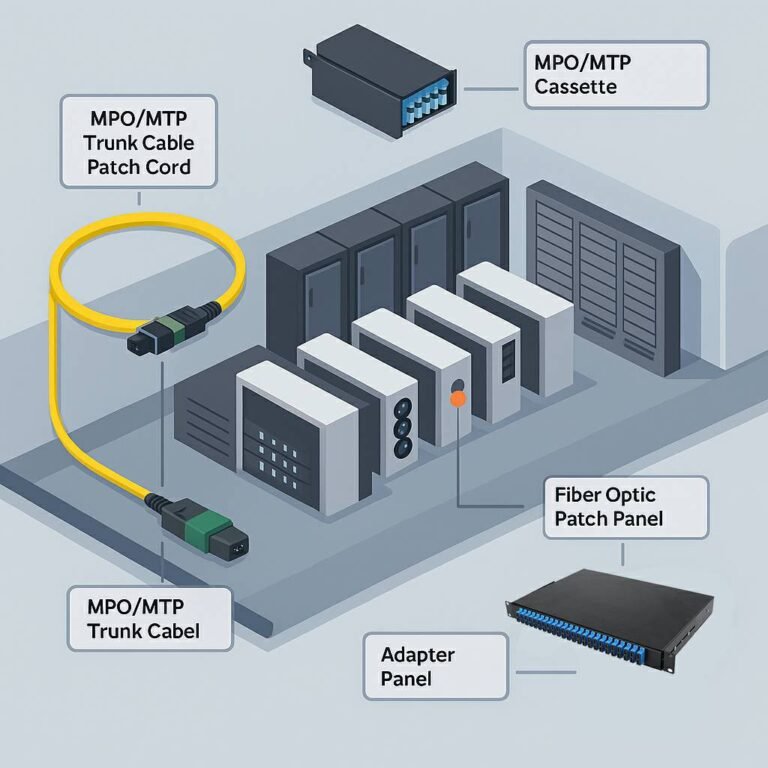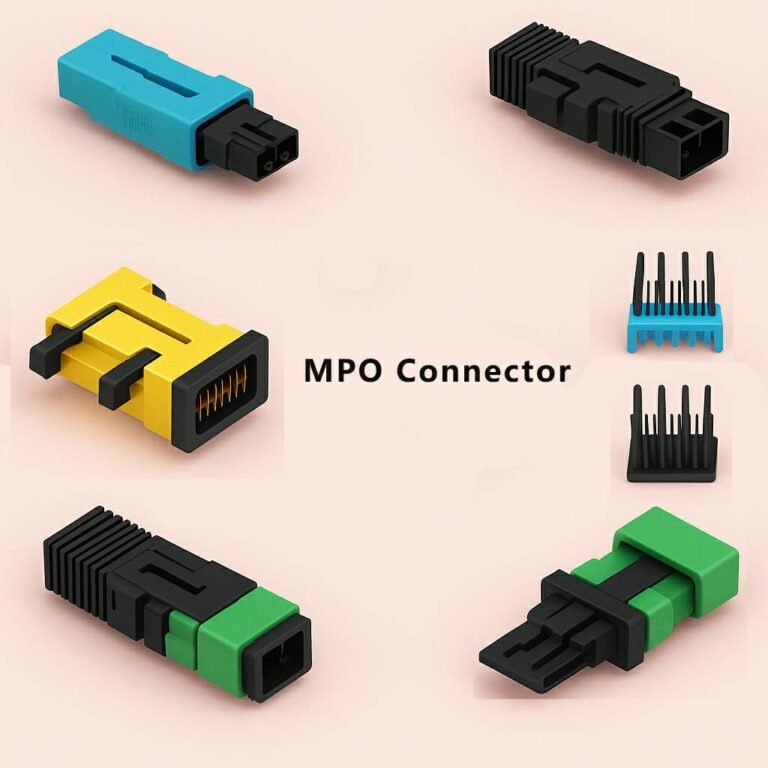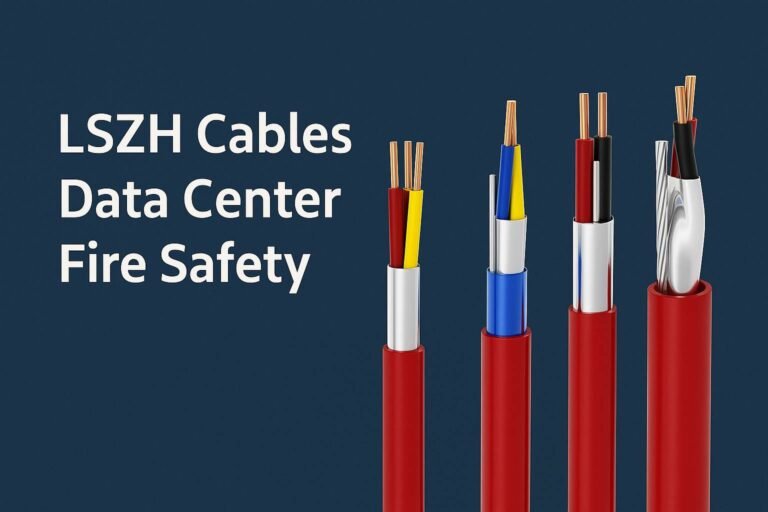What is ADSS Fiber Optic Cable? A Comprehensive Guide to ADSS's Definition and Features?

When it comes to reliable and efficient fiber optic solutions1, understanding the different types of cables is crucial. ADSS Fiber Optic Cable2 stands out as a versatile option for various installations. But what makes it different, and why should you consider it for your projects?
I remember the first time I had to choose the right fiber optic cable for a challenging outdoor project. The options were overwhelming, and making the right choice was critical for the project's success.
How Does ADSS Compare to Other Fiber Optic Cables?
Choosing the right fiber optic cable can be daunting. ADSS cables offer unique advantages over traditional fiber optic cables, especially in aerial installations3.
The story of selecting ADSS cables for a large-scale telecommunications project taught me the importance of understanding the differences between cable types.
What Sets ADSS Apart from Traditional Fiber Optic Cables?
Key Differences Between ADSS and Other Cables
ADSS4. stands for All-Dielectric Self-Supporting. Unlike traditional fiber optic cables that require metal support or additional hardware, ADSS cables are designed to support themselves.
Table: ADSS vs. Traditional Fiber Optic Cables
| Feature | ADSS Fiber Optic Cable | Traditional Fiber Optic Cable |
|---|---|---|
| Support Structure | Self-supporting, no metal needed | Requires metal support or hardware |
| Installation | Easier aerial installation | More complex installation |
| Durability | Highly resistant to environmental factors | Varies based on type |
| Cost | Generally higher upfront cost | Can be cost-effective initially |
Advantages of Being All-Dielectric
ADSS cables are made entirely of non-metallic materials, which means they don't conduct electricity. This makes them safer for installations near power lines and reduces the risk of electromagnetic interference5.
Flexibility and Strength
ADSS cables are both flexible and strong, allowing them to withstand harsh weather conditions and mechanical stresses without compromising performance.
Understanding the All-Dielectric Self-Supporting Feature of ADSS Cables
ADSS cables are engineered to support themselves without the need for additional hardware, making them ideal for various aerial applications.
In my experience, the self-supporting nature of ADSS cables simplifies the installation process, saving both time and resources.
What Makes ADSS Cables Self-Supporting?
Structural Composition
ADSS cables incorporate a robust design with materials that provide tensile strength6 and flexibility. This ensures that the cable can span long distances without sagging or requiring external support.
Components of ADSS Cables
- Core: Typically consists of multiple fiber strands for high data transmission.
- Strength Members: Made from materials like aramid yarns7 or fiberglass to provide tensile strength.
- Protective Coating: Ensures durability against environmental factors.
Installation Benefits
The self-supporting feature reduces the need for additional installation hardware, lowering overall project costs and simplifying the deployment process.
Table: Installation Comparison
| Aspect | ADSS Cables | Traditional Cables |
|---|---|---|
| Hardware Needed | Minimal to none | Requires clamps, brackets |
| Installation Time | Reduced due to fewer components | Longer installation time |
| Flexibility | High flexibility for various terrains | Less flexible, more rigid installations |
Case Study: Simplifying Aerial Installations
During a project in a densely populated urban area, the self-supporting ADSS cables allowed for a quick and efficient installation, avoiding the need for extensive hardware and minimizing disruption.
What are the Main Applications of ADSS Cables in Telecommunications?
ADSS cables play a critical role in telecommunications, particularly in aerial installations where reliability and durability are paramount.
Choosing the right application for ADSS cables can significantly enhance the performance and longevity of telecommunications networks.
Key Telecommunications Applications
FTTH (Fiber to the Home)
ADSS cables are ideal for FTTH8 deployments, providing a reliable backbone that can withstand various environmental challenges while delivering high-speed internet to consumers.
Mobile Backhaul
In supporting mobile networks9, ADSS cables ensure that data transmission remains stable and efficient, even in remote or challenging locations.
Data Centers
ADSS cables facilitate high-capacity data transfer between data centers10, ensuring seamless communication and data management.
Benefits in Data Centers
- High Bandwidth: Supports large volumes of data traffic.
- Scalability: Easily expandable to meet growing demands.
- Reliability: Minimizes downtime with robust construction.
Utility Infrastructure
ADSS cables are also used in utility infrastructure projects, providing a dependable communication link that can endure harsh environmental conditions.
Table: ADSS Applications in Telecommunications
| Application | Benefits | Example Use Case |
|---|---|---|
| FTTH | Reliable home internet delivery | Residential broadband networks |
| Mobile Backhaul | Stable data transmission | Connecting cell towers |
| Data Centers | High-capacity data transfer | Interconnecting server rooms |
| Utility Infrastructure | Durable and resilient communication | Smart grid communications |
Dive Deeper: FTTH Deployments
Why Choose ADSS for FTTH?
ADSS cables offer the durability and reliability needed for FTTH projects, ensuring that end-users receive consistent and high-quality internet service.
Installation Strategies
Implementing ADSS in FTTH involves careful planning to maximize coverage while minimizing disruptions, leveraging the cable's self-supporting properties for efficient deployment.
Dive Deeper: Mobile Backhaul Solutions
Enhancing Mobile Networks
ADSS cables support the growing demand for mobile data by providing a stable and high-capacity backbone for mobile networks.
Future-Proofing Infrastructure
With the continuous evolution of mobile technologies, ADSS cables offer the scalability needed to accommodate future advancements and increased data traffic.
What are the Advantages of Using ADSS Cables in Aerial Installations?
ADSS cables provide numerous benefits in aerial installations, including ease of installation, durability, and cost-effectiveness over time.
Choosing ADSS cables for aerial projects can lead to more efficient operations and long-term savings.
Key Advantages in Aerial Installations
Ease of Installation
ADSS cables are designed for straightforward aerial installation, reducing the need for additional support structures and simplifying the deployment process.
Durability and Longevity
Built to withstand extreme weather conditions and mechanical stresses, ADSS cables ensure a long-lasting solution with minimal maintenance requirements.
Cost-Effectiveness
While the initial investment may be higher, the reduced need for additional hardware and lower maintenance costs make ADSS cables a cost-effective choice in the long run.
Table: Advantages of ADSS in Aerial Installations
| Advantage | Description |
|---|---|
| Ease of Installation | Simplified deployment without extra hardware |
| Durability | Resistant to environmental factors |
| Cost-Effectiveness | Lower long-term maintenance and operational costs |
| Safety | Non-conductive, reducing electrical hazards |
Enhanced Safety
Being all-dielectric, ADSS cables do not conduct electricity, making them safer for installations near power lines and reducing the risk of electrical interference.
Flexibility in Deployment
ADSS cables can be installed in various terrains and conditions, offering flexibility that traditional cables may lack.
Environmental Resilience
ADSS cables are designed to resist UV radiation, moisture, and temperature fluctuations, ensuring reliable performance in diverse environments.
Dive Deeper: Installation Efficiency
Streamlining the Process
The self-supporting nature of ADSS cables allows for quicker installations, enabling projects to meet tight deadlines without compromising quality.
Reducing Project Costs
By eliminating the need for additional support structures, ADSS cables help lower the overall project budget, making them a financially prudent choice.
Dive Deeper: Maintenance and Reliability
Minimizing Downtime
ADSS cables require less maintenance compared to traditional cables, ensuring continuous operation and reducing the likelihood of unexpected downtime.
Long-Term Investment
The robust construction of ADSS cables ensures they remain functional and efficient for many years, providing a solid return on investment.
Conclusion
Understanding the unique features and advantages of ADSS Fiber Optic Cables is essential for making informed decisions in telecommunications projects. **From their all-dielectric self-supporting design to their versatile applications and cost-effectiveness, ADSS cables offer a reliable solution for aerial installations and beyond. Whether you're working on FTTH deployments, mobile backhaul, or data center connections, ADSS cables provide the durability and performance needed to meet your project's demands. By choosing ADSS, you're investing in a technology that not only enhances your network's reliability but also ensures long-term operational efficiency and safety.
For more insights and tailored solutions, feel free to reach out to me at Candy@abptel.com or visit our website at www.abptel.com.
-
Explains various fiber optic solutions and their applications in the industry. ↩
-
Provides detailed information about ADSS Fiber Optic Cables, including definition and features. ↩
-
Describes aerial installations and their significance in deploying fiber optic networks. ↩
-
Defines All-Dielectric Self-Supporting (ADSS) and its advantages over traditional cable types. ↩
-
Defines electromagnetic interference and its impact on fiber optic communications. ↩
-
Explains tensile strength and its importance in the structural integrity of fiber optic cables. ↩
-
Explains the use of aramid yarns in providing tensile strength in fiber optic cables. ↩
-
Explains FTTH technology and its role in providing high-speed internet to consumers. ↩
-
Describes mobile backhaul and its importance in supporting mobile networks. ↩
-
Provides an overview of data centers and their role in data management and communication. ↩




